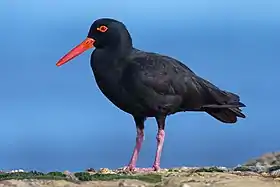Bird Island Nature Reserve
The Bird Island Nature Reserve is a protected nature reserve located near Lake Munmorah on the Central Coast region of New South Wales, Australia. The island is situated 1.4 kilometres (0.87 mi) off the east coast of New South Wales, within the Tasman Sea. The reserve may be seen from the lighthouse at Norah Head.
| Bird Island Nature Reserve New South Wales | |
|---|---|
IUCN category Ia (strict nature reserve) | |
 | |
 | |
 Bird Island Nature Reserve | |
| Nearest town or city | Budgewoi |
| Coordinates | 33°13.77′S 151°36.14′E |
| Established | June 1960 |
| Visitation | less than 10 |
| Managing authorities | NSW National Parks & Wildlife Service |
| Website | Bird Island Nature Reserve |
| See also | Protected areas of New South Wales |
Features
The island reaches a height of around 20 metres (66 ft) above sea level, and the prominent rocky cliffs make access difficult by boat.[1][2] The island was once part of the Australian mainland,[2] however it separated four to six thousand years ago with rising sea levels. The geology of the island is sedimentary rocks from the Sydney Basin.[2] The island is roughly circular in shape,[1] not more than 260 metres (850 ft) long at any point.[3]
Fauna
No introduced animals have been recorded on Bird Island Nature Reserve.[2]
Birds
Over twenty types of birds have been recorded on the island. Up to 7,000 pairs of wedge-tailed shearwaters and short-tailed shearwaters breed on the island. The sooty oystercatcher is listed as a threatened species. Other birds include, ruddy turnstone, eastern curlew, whimbrel, bar-tailed godwit, red-necked stint, Arctic jaeger, Caspian tern, common tern, white-fronted tern, white-faced storm petrel, eastern reef egret, little penguin, black cormorant, little black cormorant, white-breasted sea eagle, whistling kite and little tern. Land birds such as the Australian raven, little grassbird and welcome swallow have been recorded. A pair of peregrine falcons breed on the island; their main food consists of young white-faced storm petrels.[1][2]
Lizards
Two types of lizards have been recorded, an unidentified skink and the jacky lizard. The jacky lizard has an unusual pink mouth. No terrestrial mammals or amphibians are known here.[2]
Flora
Two types are recognised. A low open heathland with tree broom heath, an unusual variety of the Sydney golden wattle, tuckeroo, and the coastal tea tree. The flora on the more exposed areas has pigface, a tussock grass and a long stalked form of Lomandra.
Weeds
Despite the island's isolation and very few visitors, weeds are present. They include bitou bush, prickly pear, inkweed and trad. Bitou bush is affected by disease. The prickly pear can spread and diminish the area for bird's nesting sites. However, control has been sought with the use of the Cochineal insect.[2]
Aquatic life
The shallow waters near the island support blue groper, Port Jackson sharks, stingrays and cuttlefish. Reef fish and many other creatures may be found in the gutters and caves near the rocky shores.[4] Dolphins, seals, turtles and other large animals may be seen near the island. Humpback whales swim near the island during their annual migration to and from Antarctica.
Shipwrecks
A number of shipwrecks occurred at or near Bird Island. They include the Adelaide and Allenwood.[5]
References
- Lane S. G. (July 1965). Breeding Sea Birds on Bird Island – The Emu (PDF) (PDF). Volume 64, pt. 4. Retrieved 31 August 2012.
- "Munmorah State Conservation Area and Bird Island Nature Reserve Plan of Management" (PDF). NSW National Parks & Wildlife Service (PDF). Government of New South Wales. Retrieved 30 August 2012.
- Analysis from Google Earth
- Coleman, Neville. "Central Coast". Underwater Australia. Archived from the original on 14 September 2009. Retrieved 31 August 2012.
- "All Shipwrecks in the Central Coast Region". Maritime Heritage Online, New South Wales. New South Wales Government. Retrieved 31 August 2012.




